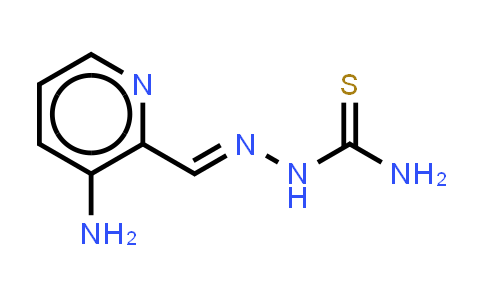| Chemical Name |
3-AP |
| CAS Number |
143621-35-6 |
| MDL Number |
MFCD00924747 |
| Molecular Formula |
C7H9N5S |
| Molecular Weight |
195.24 |
| Synonyms |
PAN-811;NSC# 663249;OCX191 |
Introduction of 143621-35-6 :
3-AP (PAN-811) is a novel inhibitor of the M2 subunit of ribonucleotide reductase (RR), and is a potent radiosensitizer. IC50 & Target: Ribonucleotide reductase (RR)[1] In Vitro: 3-AP (Triapine) is a potent derivative of α-heterocyclic carboxaldehyde thiosemicarbazone (HCT) that inhibits hRRM2 and p53R2 isoforms of the M2 subunit[1]. 3-AP (Triapine) is thought to inhibit ribonucleotide reductase through its preformed iron chelate, rather than directly by removing iron from the active site. In cells containing less topoisomerase IIα fewer DNA strand breaks will be produced, and thus topoisomerase II poisons will be less inhibitory in the K/VP.5 cell line. The IC50s for Dp44mT growth inhibition are 48±9 nM and 60±12 nM, for K562 and K/VP.5 cells, respectively. The IC50s for 3-AP growth inhibition are 476±39 nM and 661±69 nM for K562 and K/VP.5 cells, respectively[2]. PKIH and DpT Fe chelators show high antiproliferative activity against a range of tumor cell lines. Dp44mT shows the greatest antitumor efficacy with an IC50 that ranged from 0.005 to 0.4 μM. The average IC50 of Dp44mT over 28 cell types is 0.03±0.01 μM, which is significantly lower than that of 3-AP (Triapine; average IC50: 1.41±0.37 μM)[3]. In Vivo: 3-AP (Triapine) causes a significant increase (1.7-fold) in splenic weight when expressed as a percentage of total body weight (1.02±0.06%; n=25) compared with control mice (0.6±0.03%; n=27). In the long-term group, a significant increase in heart weight is observed after Dp44mT (0.4 mg/kg per day) (0.8±0.06%; n=4) compared with control mice (0.5±0.01%; n=6). A significant decrease in the expression of Ndrg1, TfR1, and VEGF1 in the liver is noted for Dp44mT- and 3-AP (12 mg/kg per day)-treated animals. The decreased expression could be related to the increased liver Fe in both Dp44mT- and 3-AP-treated mice[3].
| Purity |
NLT 98% |
| Storage |
at 20ºC 2 years |
*The above information is for reference only.
